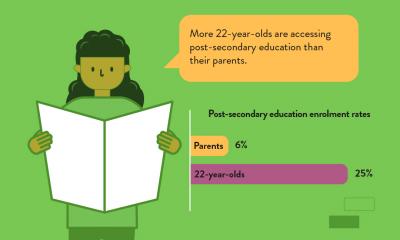
Young Lives recognizes the sustainable development goal commitment to achieve gender equality and to empower all women and girls. Gender becomes a more significant factor during adolescence, affecting boys and girls in different ways at different times. By following the life course of children as they leave early childhood, enter adolescence and transition into adulthood, we gain valuable insights into how the risks and opportunities they encounter along the way can affect their long-term outcomes.
Across all Young Lives countries both young people and their parents now believe it is acceptable to marry later and delay childbirth for economic and health reasons. However, while the rise in schooling is enabling more young people to access information about reproductive health, many girls are still entering into early marriage and childbearing, despite the association with higher infant and maternal mortality, health risks due to physical immaturity, and higher overall fertility.
The Attitudes toward Women Scale for Adolescents (AWSA) is used to better understand attitudes towards women among adolescents and young adults and was included at Round 5 (2016) for both our Younger Cohort (then aged 15 years) and Older Cohort (then age 22 years) individuals. AWSA is a 12-item scale to which individuals are asked to respond on a 4-point Likert scale ranging from strongly agree to strongly disagree. By capturing these insights for both cohorts, we can compare attitudes at different ages across statements referring to the rights, freedoms, and role of boys and girls in education, sports, dating and families, and to adult roles in parenting and housework.
One of the most frequently explored aspects of how young people spend their time is the balance between school and work. We know that a large number of children in developing countries engage in forms work, often alongside their schooling. Children’s work can include chores or paid and unpaid activities outside the home.
As such, Young Lives has built up a picture of how children use their time (elsewhere described as ‘time-use’). We know that the way children spend their time is closely linked to their wellbeing and that the paths they navigate through childhood (and the shifting shape of how they fill their days) can be hugely important markers of choices later in life and the jobs they do. Through our longitudinal approach, we are able to explore the nuances of what it means for children to be working (across both paid and unpaid activities), what domestic tasks look like, and how studying fits into this picture over the course of their lives.
Young Lives recognizes the sustainable development goal commitment to achieve gender equality and to empower all women and girls. Gender becomes a more significant factor during adolescence, affecting boys and girls in different ways at different times. By following the life course of children as they leave early childhood, enter adolescence and transition into adulthood, we gain valuable insights into how the risks and opportunities they encounter along the way can affect their long-term outcomes.
Across all Young Lives countries both young people and their parents now believe it is acceptable to marry later and delay childbirth for economic and health reasons. However, while the rise in schooling is enabling more young people to access information about reproductive health, many girls are still entering into early marriage and childbearing, despite the association with higher infant and maternal mortality, health risks due to physical immaturity, and higher overall fertility.
The Attitudes toward Women Scale for Adolescents (AWSA) is used to better understand attitudes towards women among adolescents and young adults and was included at Round 5 (2016) for both our Younger Cohort (then aged 15 years) and Older Cohort (then age 22 years) individuals. AWSA is a 12-item scale to which individuals are asked to respond on a 4-point Likert scale ranging from strongly agree to strongly disagree. By capturing these insights for both cohorts, we can compare attitudes at different ages across statements referring to the rights, freedoms, and role of boys and girls in education, sports, dating and families, and to adult roles in parenting and housework.
One of the most frequently explored aspects of how young people spend their time is the balance between school and work. We know that a large number of children in developing countries engage in forms work, often alongside their schooling. Children’s work can include chores or paid and unpaid activities outside the home.
As such, Young Lives has built up a picture of how children use their time (elsewhere described as ‘time-use’). We know that the way children spend their time is closely linked to their wellbeing and that the paths they navigate through childhood (and the shifting shape of how they fill their days) can be hugely important markers of choices later in life and the jobs they do. Through our longitudinal approach, we are able to explore the nuances of what it means for children to be working (across both paid and unpaid activities), what domestic tasks look like, and how studying fits into this picture over the course of their lives.




